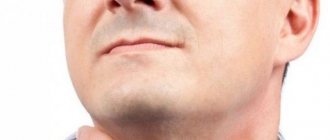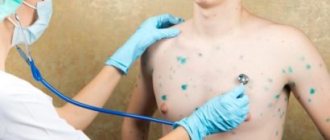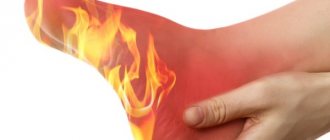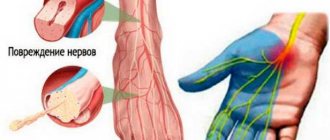The symptoms of anorexia are a set of primary and subsequent signs by which one can recognize the onset of this terrible disease and try to prevent its development.
The standard of female beauty in the modern world is considered to be thin, graceful and slender girls, shining with their beauty on fashion catwalks and on the screens of Hollywood films. It is no wonder that most teenagers, especially the fair sex, with all the fervor of youthful maximalism, strive in everything to be like their famous idols. Therefore, they consciously and purposefully refuse food, go on strict diets and simply starve themselves in order to achieve aristocratic pallor and a physique like that of well-known stars. But such abuse of one’s own body does not pass without a trace; most often it leads to the development of a disease such as anorexia.
What is such a disease? Why does it occur and how does it begin? What are the first signs of the disease and what should you focus on?
About the disease
With anorexia, patients may be thin, but still strive to lose weight. This leads to protein deficiency and is accompanied by deterioration of the nervous system and internal organs.
It is not always possible to identify clear causes for the development of anorexia, since it is a mental illness. It is believed that patients have a number of genetic, biological and mental preconditions that lead to the appearance of characteristic symptoms.
The incidence among female adolescents and adults ranges from 0.3% to 0.5%. Girls aged 15 to 20 years are most often affected. In men, pathology is observed less frequently - less than 0.01%. Such differences in morbidity are associated with differences in psychological perception.
Incidence (per 100,000 people)
| Men | Women | |||||||||||||
| Age, years | 0-1 | 1-3 | 3-14 | 14-25 | 25-40 | 40-60 | 60 + | 0-1 | 1-3 | 3-14 | 14-25 | 25-40 | 40-60 | 60 + |
| Number of sick people | 0 | 0 | 7 | 1 | 1 | 1 | 1 | 0 | 0 | 16 | 5 | 5 | 5 | 1 |
Etiology
The reasons for the development of anorexia vary among individual patients. It is believed that pathology arises due to a combination of various factors - psychological, biological, and also social. It has been noted that girls living in prosperous families and having normal or slightly increased body weight are more likely to suffer.
Experts identify the following trigger factors:
- Anorexia often occurs in people who are obese, overweight, and have early menarche. This connection is due to an imbalance of serotonin and dopamine in the brain, which leads to increased secretion of the hormone leptin. It is responsible for suppressing the feeling of hunger.
- Genetic predisposition is determined by genes encoding receptors for neurotransmitters and proteins that regulate the functioning of the central nervous system. Scientists have described two genes associated with the development of anorexia - HTR2A and BDNF. HTR2A is required for the formation of serotonin receptors in the regulatory areas of the midbrain responsible for feelings of hunger and satiety. The BDNF gene encodes a protein involved in the functioning of the hypothalamus. It is known that the hypothalamus is a key center for saturation and regulation of the endocrine system.
- Obsessive-compulsive personality type increases the risk of developing anorexia. It is often detected in adolescents and is manifested by a desire for thinness, a tendency to starvation and heavy physical activity. People experience low self-esteem, anxiety and social insecurity.
- If those around a person have a negative attitude towards excess weight and food, this creates the precondition for eating disorders in people prone to this. A similar situation is observed in families with anorexia, where children also begin to refuse to eat.
- The condition can develop against the background of severe stress. For teenagers, it could be uncertainty about the future or a tragedy with a loved one. At the same time, the patient begins to realize himself through refusal to eat and long-term exercise, which leads to symptoms of the disease.
Causes
The reasons are so varied that in some cases it can be extremely difficult to identify them. Most often, depression is the main provoking factor, but this formulation is not enough for successful treatment. Psychotherapy digs much deeper and seeks to identify more root problems.
Mental
Age factor: adolescents and young adults are at risk, and the lower bar has been falling lower and lower in recent years. Excess weight in childhood, leading to problems with the environment (pressure from parents, calling names by classmates).
The presence of a negative example in the family: relatives with anorexia, bulimia, compulsive overeating or obesity, as well as those suffering from depression, alcoholism, drug addiction. Tensed relationships in the family, too strict parents, because of which the child strives to meet high standards and becomes depressed if he does not live up to them. Lack of parental attention.
Wrong eating habits: eating unhealthy foods in large quantities, not following a diet.
Low self-esteem, self-doubt, internal complexes, feelings of inferiority. Perfectionist-obsessive personality type. Mental illnesses, neurological pathologies. Parents' divorce. The formation of personality when a teenager tries to prove to himself and others that he has willpower and can consciously refuse food in order to meet the expectations of society.
Hobbies, interests, profession requirements: actors, models, musicians, singers and other public people.
Physical
These include:
- alcoholism, drug addiction;
- aneurysm;
- anemia;
- Addison's disease;
- gastritis, pancreatitis;
- helminths;
- hemochromatosis;
- hepatitis, liver cirrhosis;
- hypopituitarism;
- hormonal dysfunction;
- zinc deficiency;
- dysfunction of neurotransmitters responsible for eating behavior (dopamine, serotonin, norepinephrine);
- prolonged coma;
- malignant tumors;
- leukemia;
- lymphoma;
- excess weight;
- neurosurgical operation;
- digestive problems, gastrointestinal diseases;
- early onset of menstruation in girls;
- sarcoidosis;
- diabetes mellitus type I;
- Kanner, Sheehan, Simmonds syndromes;
- thyrotoxicosis;
- brain injuries;
- schizophrenia;
- eclampsia.
Genetic
Not so long ago, genetics was practically not considered as one of the possible causes of anorexia, considering the latter a purely mental and social syndrome. However, not so long ago (in 2010) large-scale studies were conducted in the United States, which involved not only patients with this diagnosis, but also their closest relatives of at least 2 people. The DNA responsible for feeding behavior was studied. The results surprised many: obsessions with losing weight and refusing to eat were often determined at the chromosomal level. They found a gene for brain-derived neurotrophic factor, which differed from the others in its sensitivity to this disorder.
It is involved in stimulating appetite and satisfying hunger in the hypothalamus, and also controls the level of serotonin in the body. Researchers have concluded that people may be genetically predisposed to anorexia. This consists in the inheritance of dysfunctions of neurotransmitter systems, a certain personality type and a number of mental disorders. Moreover, in most cases, such heredity may not manifest itself throughout life. But as soon as it receives an impetus from the outside (illness, depression, taking powerful medications, long-term diet), it manifests itself in all its “glory.”
And others
Uncontrolled use of anorexigenic drugs for the purpose of losing weight. A side effect of using certain medications - hormones, psychostimulants, glucocorticosteroids.
Single stressful events that occurred 4-6 months before the onset of the eating disorder: this could be the death of a loved one or physical (sexual) abuse.
Dream of becoming a model. An obsession with thinness, which is perceived as the ideal of modern beauty. Persistent promotion of certain beauty standards in the media, passion for social networks.
Facts, facts... Sad statistics blame the family for everything, claiming that anorexia is rooted in childhood. As practice shows, teenagers suffering from this disorder have seen enough of their mother (aunt, sister) losing weight and have not been taught to eat properly.
Pathogenesis
The basis of the pathological condition is a violation of the perception of one’s own body. Patients become concerned about imaginary or real defects, as a result of which they develop obsessive and delusional thoughts. The latter are associated with excess weight, their own ugliness and a negative attitude towards their body from others. It is important to note that in reality patients have normal or slightly increased weight.
Negative thoughts about one's appearance awaken negative emotions and change behavior. A person strives to reduce body weight. As a result, food intake is limited and the feeling of hunger is dulled. The body, sensing a lack of nutrients, activates physiological mechanisms: metabolism slows down, the amount of enzymes secreted by the digestive glands, as well as insulin, decreases. The process of digesting food itself causes a feeling of discomfort and prolonged heaviness in the stomach.
In the absence of treatment, the patient completely refuses to eat, due to changes in the nervous system and the inability of the digestive system to digest food. This can cause severe exhaustion and death.
Types of anorexia
There are 3 types of disease, depending on which symptoms predominate in the patient:
- Anorexia with periods of bulimia - in addition to starvation, the sufferer experiences periodic uncontrolled gluttony. The latter leads to feelings of guilt and increased discomfort, which negatively affects the course of the disease.
- Anorexia with monothematic dysmorphophobia is a classic variant of the course. The patient has a persistent idea of losing weight, which is the goal of his daily life.
- Anorexia with vomitomania. The patient periodically experiences gluttony, after which he provokes vomiting, trying to get rid of the food he has eaten.
Identifying the clinical form of the disease is necessary to select effective drug treatment and psychotherapy. It is important to distinguish bulimia from anorexia with similar symptoms.
Stages of development
The symptoms of anorexia change in stages. Doctors distinguish 4 stages of the disease, which successively replace each other.
Stage I
The average duration of the first stage of anorexia is 1 year. In some patients it lasts from several months to 3-4 years. At this stage, a person has an idea about his own “imperfect” body, and his behavior also changes. The patient constantly thinks about how to lose weight or correct other external defects, many of which are subjective. Most often, the first stage is detected in adolescents. They notice how their own body is changing due to changes in hormonal levels and may be unhappy with its transformation.
Stage II
The next stage is the anorexic stage, accompanied by rapid loss of body weight. At the same time, the patient believes that losing weight relieves him of existing external defects. In some cases, weight is reduced by 1.5-2 times. As a result, dystrophic changes in internal organs occur, and women lose menstruation.
To reduce their own weight, patients use various methods:
- they give enemas daily using hypertonic solutions (such procedures lead to the body losing interstitial fluid and body weight decreasing);
- drink laxatives on a regular basis;
- after eating they initiate vomiting;
- engage in sports for a long time, the intensity of the load is very high;
- in some cases, patients begin to smoke and drink alcoholic beverages, associating these bad habits with weight loss.
At the second stage of the disease, the first consequences of anorexia for the body appear. The appearance of patients changes: subcutaneous fatty tissue is completely absent, constant hair loss is observed, as well as brittle nails and teeth. Doctors include inflammatory changes in the organs of the digestive system, leading to pain, stool disorders, etc., as serious complications. After eating, the patient experiences nausea, discomfort in the abdomen, dizziness and suffocation. Due to a disorder in the functioning of the autonomic nervous system, there is an increase in heart rate and increased sweating. General performance, mental and physical activity are preserved.
Stage III
The third stage is the cachectic stage with pronounced changes in the functioning of the endocrine system. In women, menstruation completely disappears. Subcutaneous fatty tissue is absent, and degenerative changes develop on the skin, including ulcerative defects. There is pronounced dystrophy in the internal organs and muscles. Upon external examination, the skin is bluish, and blood vessels are clearly visible through them. The body temperature is reduced, the sufferer experiences cold and general malaise.
Cachectic period of anorexia
Due to general dystrophy, the patient's teeth and hair fall out, and severe anemia is noted. Patients refuse to eat and drink. Convulsive symptoms are possible. A man lies in bed and does not move. At the cachectic stage, treatment of anorexia is carried out forcibly, since such changes in the body are life-threatening.
IV stage
The reduction stage is the last stage of pathology. It is characterized by a relapse of symptoms. Patients who have undergone complex therapy gain weight and get rid of complications of the disease. However, this may cause delusions about one's own body to intensify or reappear. It is difficult to completely get rid of the disease, so patients are recommended to remain under medical supervision for 2-3 years after remission.
Reviews
Below are reviews from women about anorexia. We suggest you familiarize yourself with them in order to understand how dangerous this disease is, and you should not try to reduce centimeters on your entire body in this way.
Elena, 19 years old
I never liked my own appearance. I started losing weight at the age of 14, at first I limited myself in nutrition, then I began to actively engage in sports. With a height of 165 cm, I weighed 47 kg, which was not enough for me. In a year I lost 7 kg. Thank you very much to my parents, who promptly sounded the alarm and sent me for treatment. Thanks to them I am alive now. I don’t recommend anyone to starve themselves to become thin. Believe me, it's not worth it.
Miroslava, 18 years old
Anorexia is a dangerous disease that ruins the lives of many people. To be honest, I myself was actively losing weight 2 years ago; I wanted to look like a model. But along with the weight loss, my strength also went away, and it was hard for me to move and talk. I myself asked my parents to send me for treatment. This is probably why I am alive, unlike my friend, who did not want to be treated.
Anorexia is a terrible disease that ruins the lives of many young girls. We recommend that you do not try to achieve a perfect body using this weight loss method. Play sports, stick to proper nutrition and then you will look great!
Manifestation of the disease in children
Anorexia in childhood is primary in nature, that is, it may be associated with hereditary factors. The disease is difficult to detect by pediatricians and difficult to treat. Most parents regard the child’s loss of appetite as his whim or a temporary condition, which delays the time of diagnosis. An eating disorder can manifest itself in two symptoms:
- Children begin to be capricious and cry the moment their parents invite them to eat. In this case, the child may spit out food.
- The child constantly eats the same dish, complaining that other foods make him sick. In this case, periodic vomiting may occur after meals.
In some cases, the pathology is secondary. It occurs in diseases of the digestive organs or other body systems. The most common reasons for refusing food are:
- lack of a diet, which does not allow the development of a food reflex and the preparation of the gastrointestinal tract for food intake;
- frequent snacking on foods rich in simple carbohydrates (in this case, depression of the food center and loss of appetite are observed);
- feeding the same type or using tasteless and stale foods, the child develops a dislike for them, which is manifested by nausea, vomiting and indigestion.
Many parents try to force feed their child, distracting him with cartoons and toys. However, this approach has a negative impact on eating behavior, since when food is consumed unconsciously, the work of the nerve centers is inhibited. This is manifested by increased nausea and vomiting that occurs at the sight of any food.
Classification
Anorexia is classified according to the mechanism of formation:
- neurotic - negative emotions activate excessive stimulation of the cerebral cortex;
- neurodynamic - strong stimuli, for example, pain, suppress the nerve center of the cerebral cortex, which is responsible for appetite;
- neuropsychiatric (nervous cachexia) - refusal to eat occurs due to mental disorders, for example, depression, frequent stress, schizophrenia, a strong desire to be thin.
Pathology can also be caused by hypothalamic insufficiency in children, Kanner syndrome.
Anorexia in men
Male anorexia has a number of differences in its course:
- It often occurs against the background of changes in appearance associated with somatic diseases, injuries or the consequences of surgical treatment.
- The pathology goes unnoticed by others for a long time. The male body is able to compensate for the lack of food for a long time. In this regard, the diagnosis is often made at stage 3 of the disease, when severe exhaustion is observed.
- Men seek medical help late in the development of the disorder. This is due to their negative perception of hospital visits, as well as their desire for independent treatment.
Men with anorexia have long perceived weight loss as a consequence of the negative impact of external causes. They can be difficult working conditions, intense sports, bad habits, etc. As a rule, the psychological component (negative perception of one’s own appearance, traumatic situations) is completely excluded.
Against the background of the disorder, patients begin to train more often and strive to surpass their own athletic achievements. Very often they are unrealistic, however, men continue to exercise regularly, increasing the frequency and intensity of training. This is often accompanied by a transition to vegetarianism, long-term intermittent fasting, etc.
Symptoms of Anorexia Nervosa
Nervous factors underlie adolescent anorexia. At the same time, girls suffer more often. Patients lose from 15% to 40% of body weight. Teenagers are dissatisfied with their appearance and actively try to change it, primarily through artificially induced vomiting, intense exercise, dieting, and the use of laxatives. In many cases, the behavior reaches the point of absurdity - the patient never sits, because he believes that standing loses significantly more energy.
Important changes are observed in the mental sphere. Against the background of denial of one’s own body and critical weight loss, a negative food reflex is formed, characterized by the appearance of vomiting even at the sight of food. In this case, the sufferer feels nausea in those cases when he himself begins to realize the need to restore nutrition.
Eating behavior in anorexia nervosa has a number of characteristic changes:
- in the initial stages, an obsessive desire to lose weight arises, while the weight fluctuates within normal limits or is even reduced;
- obsessions formed around losing weight lead to a narrowing of the sphere of interests (patients begin to become interested in diets, sports, count calories consumed and lose their previous hobbies);
- expressed fear of obesity and excess weight gain;
- meals have the appearance of rituals: patients spend a long time setting the table, cutting food into small pieces, and chewing them thoroughly;
- unmotivated refusals to eat are observed (as the pathology progresses, they become associated with a negative food reflex);
- patients avoid meetings and events that involve a feast or coffee break.
In addition to changes in eating behavior, a desire for loneliness and decreased contact with others, including relatives, friends and colleagues, are characteristic. When trying to point out to the patient his incorrect perception of his own body, he becomes aggressive.
Eating disorders and insufficient nutrient intake lead to physiological changes:
- tendency to fainting, as well as frequent dizziness and general weakness;
- hair loss and its replacement with vellus hairs;
- a decrease in body weight by 15% or more compared to the age norm;
- decreased libido in men and menstrual irregularities in women.
Anorexia nervosa is accompanied by psychological personality changes - the development of apathy and depression, decreased mental performance, sleep disturbances and emotional lability.
An important feature of anorexia is the lack of criticism of one’s own condition. The patient does not note exhaustion or the appearance of negative symptoms from the internal organs. Talking about losing weight leads to anger and aggression. In this regard, in case of critical exhaustion, treatment is carried out forcibly with hospitalization. In this case, nutrition is given to the patient in the form of parenteral drugs. The use of tablets is ineffective and all medications are used by injection.
Possible complications
Childhood anorexia and the disease in adults, in the absence of treatment, can cause the development of negative consequences from internal organs. If the disease develops in adolescents, there is general growth retardation and delayed sexual development.
Due to dystrophy, the functioning of the cardiovascular system suffers. Severe arrhythmias or sudden cardiac arrest may develop. Rhythm disturbances occur as a result of electrolyte disturbances in the blood and heart muscle. Complications from the gastrointestinal tract include chronic diarrhea and spastic abdominal pain associated with spasm of smooth muscles.
Due to metabolic disorders, the functioning of the endocrine system is disrupted:
- hypothyroidism develops - a decrease in the production of thyroid hormones, against this background the patient may experience swelling of the mucous membranes;
- Women experience amenorrhea and infertility.
An imbalance of ions in the blood also affects calcium metabolism. As a result, osteoporosis and osteopenia develop in the bones, leading to increased fragility and frequent fractures.
Changes in the psyche and the progressive nature of the pathology lead to an increased risk of developing depression. Patients are prone to suicide and abuse of alcohol or drugs.
Diagnostic measures
Anorexia is a separate nosological unit. A psychiatrist or psychotherapist deals with issues of diagnosis and treatment. It is important to note that various medical specialists take part in the examination, since patients tend to hide the symptoms of the disease, and anorexia leads to damage to various organs and their systems.
The diagnosis is based on a clinical history, external examination, as well as tests for anorexia presented by psychodiagnostic questionnaires. To make a diagnosis, five signs must be identified:
- Body weight deficiency. When talking about the weight at which anorexia begins, doctors highlight the mark at 15% of normal values. At the same time, the body mass index decreases to 17.5 points and below.
- Dysfunctional changes in the endocrine system. Metabolic disorders and a lack of proteins, fats and carbohydrates supplied from food lead to disruption of the hypothalamus and pituitary gland. This suppresses the function of the gonads. In this regard, men reduce the decrease in potency or loss of libido, and in women secondary amenorrhea occurs.
- The patient has obsessive ideas about his appearance and dysmorphophobia. People with anorexia inappropriately evaluate their appearance and weight, experiencing dissatisfaction with them. The fear of developing obesity and the desire to reduce body weight become extremely valuable ideas for them.
- If anorexia occurs during puberty, the development of secondary sexual characteristics slows down or is completely absent. The patient's height does not increase.
- The patient consciously changes his behavior, directing it towards weight loss. Loss of body weight is not associated with forced hunger or diseases of the internal organs. Patients avoid eating, vomit after meals, exercise intensively, and use medications aimed at losing weight.
In addition to these criteria, patients need to study the condition of their internal organs. All patients undergo electrocardiography (ECG) and ultrasound examination of the heart. These methods make it possible to detect changes in heart rhythm, as well as dystrophic processes in the myocardium. Due to the negative impact of anorexia on the endocrine system, the level of sex hormones and thyroid hormones in the blood is examined. Fibroesophagogastroduodenoscopy (FEGDS), as well as ultrasound of the liver and pancreas are indicated for abdominal pain.
Diagnostics
The main diagnostic tool for detecting the disease is the anorexia test, whose name is “Attitude to Eating”. The first part consists of 26 general and easy questions. The second is only 5, but they involve monitoring your own eating behavior over the past 6 months. This method has several significant disadvantages, due to which it is not always possible to rely on it for an accurate diagnosis.
Firstly, in most cases the patient cannot objectively assess his own eating behavior. Accordingly, he cannot truthfully answer the questions in the text.
Secondly, this test predominantly detects anorexia nervosa, while all other types require additional diagnostics.
This test can be taken by absolutely anyone online. For a more accurate diagnosis, various studies may be prescribed:
- blood, stool and urine tests;
- gastroscopy;
- MRI of the head;
- sigmoidoscopy;
- X-ray contrast examination of the digestive tract;
- esophagomanometry;
- X-ray;
- ECG.
The last resort will be a consultation with a psychotherapist. Through an interview and based on laboratory results, he makes a final diagnosis, determines the stage and prescribes treatment.
Treatment approaches
Therapy for identifying anorexia depends on the severity of the pathology, the causes of its occurrence, the age of the patient and the characteristics of his condition. Treatment can take place in a hospital or at home with outpatient visits to specialists. The main goals of therapy are to restore an adequate perception of one’s own body, normalize nutrition and body weight. Anorexia can be cured with an integrated approach that includes 3 methods.
1. Individual psychotherapy
Experts recommend the cognitive-behavioral approach, which has the most evidence of its effectiveness in treating this type of disorder. They work with the patient, explaining the possible negative consequences of refusing food, help restore a positive perception of their body and personality, and also reduce the overall level of anxiety. The treatment ends with the development of mindfulness techniques that allow you to regain a sense of pleasure from eating, playing sports and communicating with others.
2. Diet therapy
Mandatory part of treatment. The work is carried out not only with the patient, but also with his relatives. They explain the need for regular food intake and the negative consequences of refusing it. All patients are prescribed therapeutic nutrition aimed at gradually increasing the calorie intake and normalizing body weight.
3. Use of drugs
The measure is aimed at eliminating symptoms. Drugs of various pharmacological groups are used.
The start of therapy should coincide with the time of the appearance of the first signs of pathology, which, according to statistics, increases its effectiveness.
Use of medications
Medicines are used depending on the symptoms present. If the disease develops in adolescence, to accelerate growth and strengthen the skeletal system, sex hormone replacement therapy is used, which also prevents damage to internal organs.
If obsessive-compulsive symptoms and motor agitation are detected, antipsychotics are prescribed. Preference is given to atypical drugs - Risperidone, etc. They not only eliminate these symptoms, but also facilitate weight gain with long-term use.
Selective serotonin reuptake inhibitors (Fluoxetine, etc.) reduce the risk of relapse, and therefore are used after patients are discharged and their weight is normalized. The drugs positively change the attitude towards one’s own appearance.
Any medications are prescribed only by a psychiatrist, as they have certain contraindications for their use. When trying to self-medicate, it is possible that disorders of the internal organs or nervous system may progress, as well as the development of side effects of the medications themselves.
Diet therapy
Diet changes are indicated for all patients with anorexia. The diet is based on the following recommendations:
- Nutrition should be balanced.
- Serving sizes are selected individually. As a rule, at the beginning of therapy they are reduced. This helps reduce fears about gaining excess weight and obesity.
- The diet mainly consists of semi-liquid and liquid dishes. This prevents the occurrence of nausea and vomiting, including those caused by the patient himself.
- To compensate for vitamin deficiencies, it is recommended to eat a large amount of vegetables, fruits and berries.
- Switch to fractional meals. You need to eat 5 meals a day: three main meals and 2 snacks.
- It is recommended to drink at least 2 liters of water during the day to replenish water reserves in the body.
Nutritionists highlight lists of permitted and prohibited foods. All patients with anorexia are advised to consume lean meats (rabbit, chicken) and fish (pollock, hake), vegetable oils, fresh berries and fruits, fermented milk products (sour cream, cottage cheese, yogurt, kefir), durum pasta, cereals, nuts and dried fruits. Restrictions apply to canned foods, margarine and spreads, confectionery, mayonnaise, any fast food, sausages and canned vegetables.
It is recommended to give preference in food to homemade dishes, as they do not contain preservatives, dyes or flavors.
Weight restoration
To gain weight, the patient uses nutrition based on several principles:
- Gradual increase in calorie content of foods. The organs of the digestive system after prolonged anorexia are not ready to digest a large amount of food. In this regard, caloric content and portion sizes increase gradually.
- The diet should contain only products from the list of permitted products. Eating fatty, spicy or salty foods can cause discomfort, nausea or abdominal pain, which makes recovery difficult and may cause a relapse.
- During the recovery process, regular measurements of body weight are carried out, as well as anthropometric data (waist, abdominal, etc.) to assess the rate of weight gain and its normalization.
- The nutritionist discusses with the patient the need for proper nutrition, since full recovery from anorexia is possible with good motivation from the patient.
During the rehabilitation period, work with a psychotherapist continues. Psychotherapeutic treatment can be individual or group.
Primary therapy
If the patient himself consults a doctor and realizes that he has problems, then treatment can be outpatient, but in most cases hospitalization and a long hospital stay are required. Treatment is carried out in several mandatory stages:
- Non-specific. 2-3 weeks. Strict adherence to bed rest and the appointment of an individual diet are required. To prevent the patient from refusing food, insulin is injected intramuscularly, adding 4 units per day. An hour after the injection, he begins to have an appetite. If the patient refuses food, he is transferred to compulsory treatment, a glucose solution with insulin is administered intravenously, and he is fed through a tube.
- Specific. It begins when the patient gains 2-3 kg. The duration of specific therapy is 7-9 weeks. Semi-bed rest is observed, gradually transitioning to normal. Psychotherapy begins, the consequences of fasting are explained to the patient, and family sessions are held.
Individual diet
The nutrition plan is developed taking into account the physiological and mental characteristics of each patient. Table No. 11 according to Pevzner is taken as a basis. It aims to restore the chemical composition of tissues and the proper functioning of body cells. Features of an individual diet:
- The primary calorie content of the daily diet at the nonspecific stage of treatment is 500 kcal.
- 6 meals of 50-100 g are prescribed. First, they give everything liquid, diluted juices. Grinded dishes are added later. The diet consists of compotes, jelly, smoothies, jellies, liquid porridges in water with a small amount of milk, baby food, cottage cheese, weak meat and fish broths.
- The hospital staff ensures that the patient does not spit out food.
- To prevent vomiting, the patient may be given atropine subcutaneously.
- When a specific stage of treatment begins, the patient is transferred to a vegetarian and then a high-calorie diet. Gradually, steamed and boiled fish, meat chopped with a blender, jellied dishes, omelettes, pates, and salads are introduced into the diet.
Forecast
The prognosis depends on the timing of the start of treatment. The earlier therapy begins, the more effective it is. The best prognosis is observed in people who undergo complex treatment using medications, psychotherapy and diet. In this case, it is necessary to eliminate possible causative factors in the development of incorrect perception of one’s own body. In this regard, psychological support from family and friends is important.
If psychogenic anorexia is detected at the third stage against the background of severe cachexia, the prognosis is unfavorable. Severe dystrophic changes in internal organs lead to secondary diseases: heart rhythm disturbances, ulcerative lesions of the gastrointestinal tract, etc. In the absence of forced and long-term treatment, these pathological changes progress and can lead to fatal complications.
A negative prognosis is observed when there is excessive pressure from others or failure to visit a psychotherapist. This category of patients is prone to depression, drug addiction and has a high risk of suicide attempts.
Prevention options
Prevention of anorexia is based on following simple recommendations:
- Parents need to talk with their children about the importance of proper nutrition, exercise and a healthy weight.
- Rituals play an important role in the family - eating together, a positive attitude towards the appearance of its members and constant support. They allow the child to form an adequate attitude towards nutrition and his body.
- Children and adults are advised to exclude fast food and other harmful foods from their diet, and also exercise regularly. Doctors believe that to maintain normal weight, 3-4 workouts of 30-40 minutes per week are enough.
- Adolescents and adults who regularly visit a psychotherapist have a low risk of developing psychological illnesses. The specialist helps to identify obsessive thoughts and internal conflicts and get rid of them.
- Psychosomatics is of great importance in the development of anorexia. In this regard, a person needs to minimize stressful situations in his life. This is especially important for teenagers who may experience psychological difficulties in connection with learning and communicating with peers.
Speaking about the prevention of anorexia, it is important to know how it appears and what the first signs are. This is necessary for timely detection of the disease and prescribing treatment.
You may also be interested in:
Recovery period
If the diagnosis reveals anorexia, then there is a long road ahead to a healthy perception of yourself and your body. To recover from prolonged exhaustion, it is important to observe bed rest for the first time. You should not start activity even if you feel relief - it can be deceptive.
During this period, it is especially important to monitor your food intake. It is better to eat small meals many times a day. Treatment usually involves six meals a day. It is not recommended to replace high-calorie foods with their analogues, since the body needs nutrients.
Anorexia causes fear of gaining life-saving weight. Group therapy helps, where you can communicate with people who are recovering or even coping with the disease.
Individual consultations with a psychologist are also important, because the symptom of hatred of one’s body does not appear without reason. If internal conflicts are not resolved, treatment will be useless. It is important to diagnose other psychological problems - depression, trauma.











